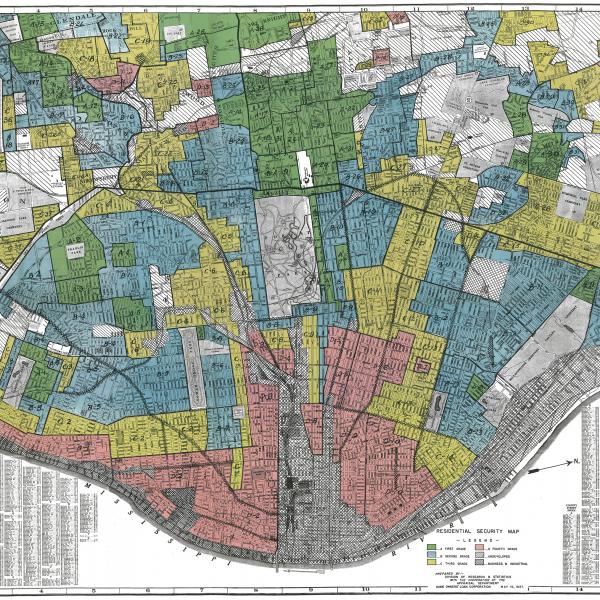Collaborative, Mellon-funded project to highlight St. Louis arts and culture
The story of St. Louis often is told through the language of division. North versus south. City versus county. The legacy of segregation and the stubborn persistence of the Delmar Divide.
Over the last decade, The Divided City, an urban humanities initiative at Washington University in St. Louis, has sponsored dozens of classes, seminars and research projects grappling with those difficult histories and their contemporary effects.

This fall, building on that work, WashU will launch a new initiative: The Engaged City. Funded by a $500,000 grant from the Mellon Foundation, with additional support from the Office of the Provost, the Engaged City aims to highlight St. Louis’ cultural resources — and to reframe how the city sees, understands and talks about itself.
“The Engaged City is about paying homage to St. Louis,” said Tila Neguse, senior associate director of WashU’s Center for the Study of Race, Ethnicity & Equity (CRE2) and one of four principal investigators for The Engaged City. “We want to focus on what bring us together rather than what tears us apart.
“We want to reclaim St. Louis’ cultural legacy.”
Beyond the academy
In addition to Neguse, principal investigators for The Engaged City are Matthew Bernstine, associate director of the Office for Socially Engaged Practice at WashU’s Sam Fox School of Design & Visual Arts; Bruce Lindsey, the E. Desmond Lee Professor for Community Collaboration in the Sam Fox School; and Laura Perry, assistant director for research and public engagement at the Center for the Humanities in Arts & Sciences.

Perry said The Divided City, which also was funded by the Mellon Foundation, “transformed the way we work with off-campus organizations. It created important long-term relationships and taught us real lessons about how to be a good neighbor and how to center community engagement within academic research.
“Now, with the Engaged City, we’re thinking about how to create tools that will be useful to people beyond the academy,” Perry added.
Over the next three years, The Engaged City will develop three central, and interrelated, projects: a cultural asset map, a community fellowship program and seed grant opportunities.
The Rev. Charles Norris, pastor of the St. James African Methodist Episcopal Church, in the Greater Ville Neighborhood, first suggested the cultural asset map, Bernstine explained.
“It’s an action-oriented approach,” Bernstine said. “This will be a digital map that marks cultural resources — places, people, events and happenings — throughout the city. Rather than pure research, it’s the sort of community engagement information that can be put to immediate use.”
Neguse added that, while the map will include major cultural institutions, it also aims to showcase grassroots efforts and organizations.
“People need to know just who is doing what in our city so that we can join efforts and better serve communities and neighborhoods,” she said.

Public engagement
Critically, the cultural asset map will be developed in partnership with the Engaged City’s new Community Fellow in Residence Program.
Residencies, which are open to a wide range of applicants, from writers and illustrators to data scientists and visual artists, will begin this fall. Selected fellows will partner with one of the three sponsoring partners — CRE2, the Sam Fox School or the Center for the Humanities — and will contribute to the creation and dissemination of the cultural asset map. Each residency will be for one year, with a chance for renewal, and will include a $20,000 honorarium.

“The idea is to give St. Louis artists and creators opportunities to immerse themselves at WashU while providing local expertise and facilitating public engagement,” Neguse said. “Fellows will explore ways in which their work can impact campus, community and the city.”
Similarly, the Engaged City seed grants will be open to community organizations and individuals identified through the asset mapping project as well as to WashU faculty. Other initiatives will include an academic conference on the urban humanities; a new course, “Mapping the Engaged City,” for students in the humanities and in design; and a variety of public-facing programs, exhibitions and events.
“Cities are engines of culture, art and economics,” said Lindsey, a professor of architecture who previously served as PI for the Mellon grants that funded The Divided City. “They can also be engines for equity and engagement when people who haven’t had the chance to be involved are able to be involved. If the university is not involved in the city where it resides, the ivory tower prevails.
“The Engaged City project is about the university getting out but also bringing the city in,” Lindsey concluded. “In St. Louis, for St. Louis.”
More details, including information about fellowship applications, will be announced in the coming weeks on The Engaged City website.
Headline image: Shine Goodie (left) is founder of the literary reading series Goodie House, which won a Divided City community grant in 2022. Also pictured are readers Aaron Coleman (MFA ’15, PhD ’21) (second from left), Maurice Tracy, Sarah Gibson Tisdale and Justin Phillip Reed (MFA ’15). (Photo courtesy of The Divided City)





